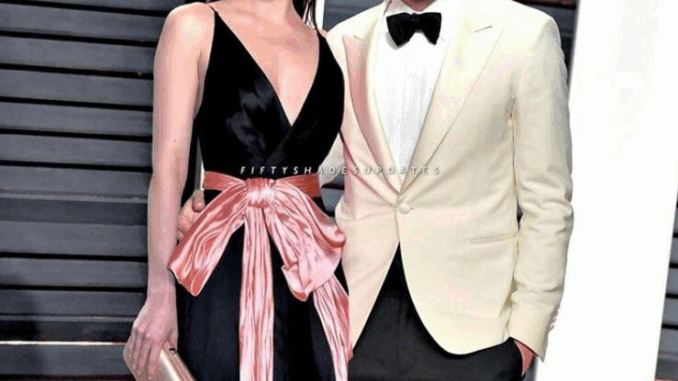
When the lights dimmed and the final cut was called, the world assumed the stars of Fifty Shades of Grey would bask in the glow of global fame and box office success. Instead, whispers started to circulate. Did Dakota Johnson and Jamie Dornan truly embrace the roles that made them household names—or did they quietly wish they’d never signed those contracts in the first place? Behind the carefully edited press interviews, behind the red-carpet smiles, lies a far more complex truth—one that paints a different picture of Hollywood’s most controversial on-screen couple.
From the very beginning, the Fifty Shades trilogy was never a “safe” choice for any actor’s career. The books by E. L. James had a dedicated fanbase but were also drenched in controversy—criticized for their portrayal of power, consent, and erotic obsession. When Universal Pictures announced Dakota and Jamie as the leads, they were stepping into a cultural firestorm. Every headline dissected the decision: “Too risky,” “career suicide,” “bold beyond reason.” And yet, they accepted.
But almost immediately after filming began, the cracks started to show. Multiple crew members have recalled that the atmosphere on set wasn’t always as heated as it appeared on screen. There were tensions—not just creative differences between director Sam Taylor-Johnson and E. L. James, but also moments when Dakota and Jamie’s working relationship was tested. It wasn’t animosity, exactly, but an undeniable undercurrent of strain.
The press tours told a different story—smiles, playful banter, and interviews where the two joked about awkward sex scenes. Yet fans with sharp ears noticed the little slips. Dakota once remarked in an interview that some scenes were “emotionally exhausting” in ways she hadn’t expected. Jamie, in another, said bluntly, “I’m glad I can leave Christian Grey behind now.” Both statements were brushed off by PR teams as casual comments, but to those who read between the lines, they hinted at deeper feelings.
The truth is, filming Fifty Shades demanded more than physical vulnerability—it required emotional exposure. Both actors were constantly aware of the magnifying glass over their performances. The pressure was immense: a worldwide audience ready to judge their chemistry, their bodies, their every gesture. And when the reviews came in, they were far from kind. Critics tore the movie apart, with some even directing personal jabs at the leads’ acting abilities. That’s the kind of criticism that leaves a mark.
Dakota, in particular, faced the challenge of avoiding being typecast. For a young actress with ambitions beyond erotica, being “Anastasia Steele” could have been a permanent label. And while she’s since built a career with diverse roles, there’s no denying that the shadow of Fifty Shades still lingers. Every red carpet appearance, every new project, still draws a wave of questions about those films—questions she sometimes answers with a strained smile, other times with a subtle roll of her eyes.
Jamie’s situation was equally complex. Already a model-turned-actor, Fifty Shades was his biggest role to date. But instead of catapulting him into a new league of leading-man opportunities, it created an image he couldn’t quite shake. He’s admitted in later interviews that the franchise wasn’t exactly his comfort zone, and while he’s careful with his words, his tone often betrays a sense of wanting to move on—fast.
And yet, here’s the twist: both Dakota and Jamie have also expressed moments of gratitude for the experience. They acknowledge that it opened doors, gave them a platform, and introduced them to a massive fanbase. It’s this contradiction—publicly polite appreciation mixed with flashes of private regret—that keeps the speculation alive. Did they truly enjoy making the films, or have they simply learned to live with the consequences?

Insiders claim that, in private conversations, the two leads have joked about the absurdity of certain scenes. One crew member recalls a moment between takes when Dakota quipped, “If my grandparents see this, I’m changing my name.” Jamie allegedly responded with a laugh but didn’t disagree. Those little glimpses paint a picture of two actors aware of how surreal—and at times, uncomfortable—their work was.
Over the years, as sequels Fifty Shades Darker and Fifty Shades Freed rolled out, the dynamic between Dakota and Jamie seemed to shift. The first film’s press tour had an awkward edge; by the third, there was a warmth, a camaraderie, even a sense of “we survived this together.” Still, when asked point-blank if they’d reprise the roles, both have given diplomatic but noncommittal answers. That hesitation says as much as any confession.
What’s perhaps most telling is how rarely they reference Fifty Shades without being prompted. In a career retrospective, most actors will fondly recall their breakout role; Dakota and Jamie seem to keep theirs at arm’s length. This isn’t bitterness—it’s self-preservation. Hollywood is fickle, and while scandal sells tickets, it doesn’t always build the kind of reputation that sustains decades-long careers.
The irony, of course, is that the very thing they may have mixed feelings about is also the thing that made them unforgettable to millions. For fans, Fifty Shades wasn’t just a film—it was a cultural moment, an escape, and in some cases, a fantasy they wanted to live out. And for Dakota and Jamie, it was a complicated chapter: one that gave them fame, tested their resilience, and perhaps left them wondering—if they could go back, would they still say yes?
So did they regret it? The answer isn’t simple. It’s layered with gratitude, frustration, pride, and maybe a touch of embarrassment. But one thing’s for sure: even if they never speak of it again, Fifty Shades will always be part of their story—and ours.
